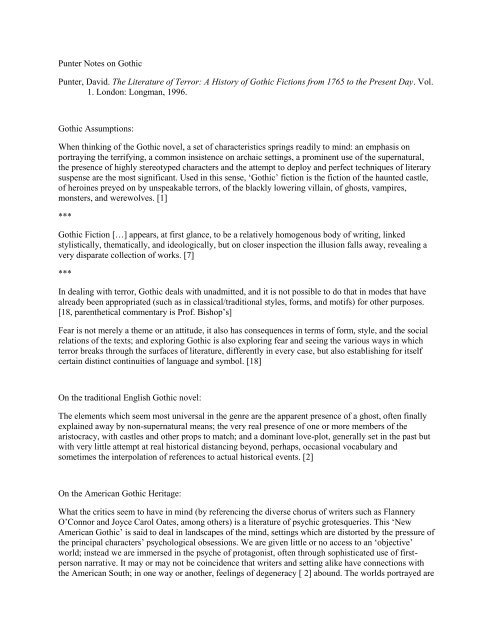Punter Notes on Gothic Punter, David. The Literature of Terror: A ...
Punter Notes on Gothic Punter, David. The Literature of Terror: A ...
Punter Notes on Gothic Punter, David. The Literature of Terror: A ...
Create successful ePaper yourself
Turn your PDF publications into a flip-book with our unique Google optimized e-Paper software.
<str<strong>on</strong>g>Punter</str<strong>on</strong>g> <str<strong>on</strong>g>Notes</str<strong>on</strong>g> <strong>on</strong> <strong>Gothic</strong><br />
<str<strong>on</strong>g>Punter</str<strong>on</strong>g>, <strong>David</strong>. <strong>The</strong> <strong>Literature</strong> <strong>of</strong> <strong>Terror</strong>: A History <strong>of</strong> <strong>Gothic</strong> Ficti<strong>on</strong>s from 1765 to the Present Day. Vol.<br />
1. L<strong>on</strong>d<strong>on</strong>: L<strong>on</strong>gman, 1996.<br />
<strong>Gothic</strong> Assumpti<strong>on</strong>s:<br />
When thinking <strong>of</strong> the <strong>Gothic</strong> novel, a set <strong>of</strong> characteristics springs readily to mind: an emphasis <strong>on</strong><br />
portraying the terrifying, a comm<strong>on</strong> insistence <strong>on</strong> archaic settings, a prominent use <strong>of</strong> the supernatural,<br />
the presence <strong>of</strong> highly stereotyped characters and the attempt to deploy and perfect techniques <strong>of</strong> literary<br />
suspense are the most significant. Used in this sense, ‘<strong>Gothic</strong>’ ficti<strong>on</strong> is the ficti<strong>on</strong> <strong>of</strong> the haunted castle,<br />
<strong>of</strong> heroines preyed <strong>on</strong> by unspeakable terrors, <strong>of</strong> the blackly lowering villain, <strong>of</strong> ghosts, vampires,<br />
m<strong>on</strong>sters, and werewolves. [1]<br />
***<br />
<strong>Gothic</strong> Ficti<strong>on</strong> […] appears, at first glance, to be a relatively homogenous body <strong>of</strong> writing, linked<br />
stylistically, thematically, and ideologically, but <strong>on</strong> closer inspecti<strong>on</strong> the illusi<strong>on</strong> falls away, revealing a<br />
very disparate collecti<strong>on</strong> <strong>of</strong> works. [7]<br />
***<br />
In dealing with terror, <strong>Gothic</strong> deals with unadmitted, and it is not possible to do that in modes that have<br />
already been appropriated (such as in classical/traditi<strong>on</strong>al styles, forms, and motifs) for other purposes.<br />
[18, parenthetical commentary is Pr<strong>of</strong>. Bishop’s]<br />
Fear is not merely a theme or an attitude, it also has c<strong>on</strong>sequences in terms <strong>of</strong> form, style, and the social<br />
relati<strong>on</strong>s <strong>of</strong> the texts; and exploring <strong>Gothic</strong> is also exploring fear and seeing the various ways in which<br />
terror breaks through the surfaces <strong>of</strong> literature, differently in every case, but also establishing for itself<br />
certain distinct c<strong>on</strong>tinuities <strong>of</strong> language and symbol. [18]<br />
On the traditi<strong>on</strong>al English <strong>Gothic</strong> novel:<br />
<strong>The</strong> elements which seem most universal in the genre are the apparent presence <strong>of</strong> a ghost, <strong>of</strong>ten finally<br />
explained away by n<strong>on</strong>-supernatural means; the very real presence <strong>of</strong> <strong>on</strong>e or more members <strong>of</strong> the<br />
aristocracy, with castles and other props to match; and a dominant love-plot, generally set in the past but<br />
with very little attempt at real historical distancing bey<strong>on</strong>d, perhaps, occasi<strong>on</strong>al vocabulary and<br />
sometimes the interpolati<strong>on</strong> <strong>of</strong> references to actual historical events. [2]<br />
On the American <strong>Gothic</strong> Heritage:<br />
What the critics seem to have in mind (by referencing the diverse chorus <strong>of</strong> writers such as Flannery<br />
O’C<strong>on</strong>nor and Joyce Carol Oates, am<strong>on</strong>g others) is a literature <strong>of</strong> psychic grotesqueries. This ‘New<br />
American <strong>Gothic</strong>’ is said to deal in landscapes <strong>of</strong> the mind, settings which are distorted by the pressure <strong>of</strong><br />
the principal characters’ psychological obsessi<strong>on</strong>s. We are given little or no access to an ‘objective’<br />
world; instead we are immersed in the psyche <strong>of</strong> protag<strong>on</strong>ist, <strong>of</strong>ten through sophisticated use <strong>of</strong> firstpers<strong>on</strong><br />
narrative. It may or may not be coincidence that writers and setting alike have c<strong>on</strong>necti<strong>on</strong>s with<br />
the American South; in <strong>on</strong>e way or another, feelings <strong>of</strong> degeneracy [ 2] abound. <strong>The</strong> worlds portrayed are
<strong>on</strong>es infested with psychic and social decay, and coloured with the heightened hues <strong>of</strong> putrescence.<br />
Violence, rape and breakdown are the key motifs; the crucial t<strong>on</strong>e is <strong>on</strong>e <strong>of</strong> desensitized acquiescence in<br />
the horror <strong>of</strong> obsessi<strong>on</strong> and prevalent insanity. [3]<br />
On Modern and C<strong>on</strong>temporary <strong>Gothic</strong> writing:<br />
And ‘<strong>Gothic</strong>’ is also used in a less tendentious sense to refer to horror ficti<strong>on</strong> itself, in the comm<strong>on</strong> form<br />
<strong>of</strong> the ghost story. Here there is a clear historical element in the usage: many <strong>of</strong> best-known masters <strong>of</strong><br />
supernatural ficti<strong>on</strong>—Algern<strong>on</strong> Blackwood, M. R. James, H. P. Lovecraft—derive their techniques <strong>of</strong><br />
suspense and their sense <strong>of</strong> the archaic directly from the original <strong>Gothic</strong> ficti<strong>on</strong>, and many <strong>of</strong> their crucial<br />
symbols <strong>of</strong> the supernatural were previously the property <strong>of</strong> these older writers. This is not, <strong>of</strong> course, to<br />
say that all twentieth-century horror ficti<strong>on</strong> has its roots in the <strong>Gothic</strong>: but it remarkable how much <strong>of</strong> it<br />
does, how much <strong>of</strong> it relies <strong>on</strong> themes and styles which, by rights, would seem to be more than a century<br />
out <strong>of</strong> date. [3]<br />
***<br />
Another type <strong>of</strong> interpretati<strong>on</strong> <strong>of</strong> <strong>Gothic</strong> is suggested by Angela Carter in the Afterword to her collecti<strong>on</strong><br />
<strong>of</strong> tales, Fireworks (1974), where she discusses her own debt to the ‘<strong>Gothic</strong> traditi<strong>on</strong>’ as represented by<br />
Edgar Allan Poe:<br />
<strong>The</strong> <strong>Gothic</strong> traditi<strong>on</strong> in which Poe writes grandly ignores the value systems <strong>of</strong> our instituti<strong>on</strong>s; it deals<br />
entirely with the pr<strong>of</strong>ane. Its great themes are incest and cannibalism. Character and events are exaggerated<br />
bey<strong>on</strong>d reality, to become symbols, ideas, passi<strong>on</strong>s. Its style will tend to be ornate, unnatural—and thus<br />
operate against the perennial human desire to believe the word as fact. Its <strong>on</strong>ly humour is black humour. It<br />
retains a singular moral functi<strong>on</strong>—that <strong>of</strong> provoking unease.<br />
A particular attitude towards the recapture <strong>of</strong> history; a particular kind <strong>of</strong> literary style; a versi<strong>on</strong> <strong>of</strong> selfc<strong>on</strong>scious<br />
un-realism; a mode <strong>of</strong> revealing the unc<strong>on</strong>scious; c<strong>on</strong>necti<strong>on</strong>s with the primitive, the barbaric,<br />
the tabooed—all <strong>of</strong> these meanings have attached themselves in <strong>on</strong>e way or another to the idea <strong>of</strong> <strong>Gothic</strong><br />
ficti<strong>on</strong>, and our present apprehensi<strong>on</strong> <strong>of</strong> the term is usually an uneasy c<strong>on</strong>catenati<strong>on</strong> <strong>of</strong> them, in which<br />
there is a complicated interplay <strong>of</strong> direct historical c<strong>on</strong>necti<strong>on</strong>s and ever variable metaphor. [4]<br />
<strong>The</strong> historical roots <strong>of</strong> the term:<br />
<strong>The</strong> original meaning, not unnaturally, was literally ‘to do with the Goths’, or with the barbarian northern<br />
tribes who played […] a part in the collapse <strong>of</strong> the Roman empire, although even this apparently literal<br />
meaning was less simple than it appears, because the seventeenth- and early eighteenth-century writers<br />
who used the term in this sense had very little idea <strong>of</strong> who the Goths were or what they were like. One<br />
thing that was known was that they came from northern Europe, and thus [4] the term has a tendency to<br />
broaden out, to become virtually a syn<strong>on</strong>ym for ‘Teut<strong>on</strong>ic’ or ‘Germanic’, while retaining its c<strong>on</strong>notati<strong>on</strong>s<br />
<strong>of</strong> barbarity. [5]<br />
[For eighteenth-century English writers] ‘<strong>Gothic</strong>’ become descriptive <strong>of</strong> things medieval […] that is in<br />
oppositi<strong>on</strong> to ‘classical’ [having to do with Rome, the Romans, Athens, or the Greeks]. […] Where the<br />
classical was well-ordered, <strong>Gothic</strong> was chaotic; where simple and pure, <strong>Gothic</strong> was ornate and<br />
c<strong>on</strong>voluted; where the classics <strong>of</strong>fered a set <strong>of</strong> cultural models to be followed, <strong>Gothic</strong> represented excess<br />
and exaggerati<strong>on</strong>, the product <strong>of</strong> the wild and the uncivilized.
<strong>Gothic</strong> was the archaic, the pagan, that which was prior to, or was opposed to, or resisted the<br />
establishment <strong>of</strong> civilized values and a well-regulated society. And various writers, starting from [the<br />
eighteenth-century <strong>on</strong>], began to make out a case for the importance <strong>of</strong> these <strong>Gothic</strong> qualities and to<br />
claim, specifically, that the fruits <strong>of</strong> primitivism and barbarism possessed a fire, a vigour, a sense <strong>of</strong><br />
grandeur which was sorely needed in English culture. [5]<br />
On Bishop Hurd’s views <strong>of</strong> the <strong>Gothic</strong> and genius, and the larger c<strong>on</strong>text:<br />
[Bishop Hurd (1762) asserts] ‘May there not be something in the <strong>Gothic</strong> Romance peculiarly suited to the<br />
views <strong>of</strong> a genius, and to the ends <strong>of</strong> poetry?’<br />
One can point to four principal areas <strong>of</strong> past literature which were brought back into cultural prominence<br />
under the aegis <strong>of</strong> the ‘revival <strong>of</strong> the <strong>Gothic</strong>’.<br />
First, there was the truly ancient British heritage, ins<strong>of</strong>ar as any <strong>of</strong> it was available in the eighteenth<br />
century. [<strong>The</strong>se works helped to reacquaint readers with the history <strong>of</strong> northern Europe]<br />
Sec<strong>on</strong>d, there were the ballads. [Thomas] Percy’s crucial collecti<strong>on</strong>, Reliques <strong>of</strong> Ancient English Poetry,<br />
was published in 1765, and it was the re-establishment <strong>of</strong> the credentials <strong>of</strong> this form <strong>of</strong> ‘folk-poetry’<br />
which led <strong>on</strong>, through poems like Blake’s ‘Gwin, the King <strong>of</strong> Norway’, written in the 1770s, to<br />
Coleridge’s ‘Ancient Mariner’ (1797-8) and Keats’s ‘La Belle Dame sans Merci’ and [Percy] Shelley’s<br />
Mask <strong>of</strong> Anarchy, both written in 1819.<br />
Third, <strong>Gothic</strong> was taken to include English medieval poetry, preeminently the works <strong>of</strong> Chaucer, which<br />
were given a scholarly editi<strong>on</strong> by Thomas Tyrwhitt in 1775-8.<br />
And fourthly, it included, as least [6] for some critics and writers, the major works <strong>of</strong> Spenser and the<br />
Elizabethans which, it now came to be thought, had been buried under the reputati<strong>on</strong> <strong>of</strong> the achievements<br />
<strong>of</strong> the mid-seventeenth century. [7]<br />
***<br />
Characteristics <strong>of</strong> <strong>Gothic</strong> literature [and film!]:<br />
[<strong>Gothic</strong> literature] was an extremely copious and popular form <strong>of</strong> ficti<strong>on</strong>; during the 1790s at least, it<br />
virtually dominated the novel market. […]<br />
Many <strong>of</strong> the novels were set in the past, sometimes <strong>on</strong>ly nominally, sometimes with c<strong>on</strong>siderable effort.<br />
Many <strong>of</strong> them used castles, ruins, c<strong>on</strong>vents as settings. And many <strong>of</strong> them deliberately set out to portray<br />
precisely those manifestati<strong>on</strong>s <strong>of</strong> the wild and the barbaric which appeared to appeal to the taste <strong>of</strong> the<br />
day. [7] […] many <strong>of</strong> them were more or less crudely sensati<strong>on</strong>alist, in that they tended to derive their<br />
force from the portrayal <strong>of</strong> extreme situati<strong>on</strong>s, mostly situati<strong>on</strong>s <strong>of</strong> terror. It is partly for this reas<strong>on</strong> that<br />
<strong>Gothic</strong> has not been well treated by literary critics; it has been said that it was crude, exploitative, even<br />
sadistic, and that it pandered to the worst in popular taste <strong>of</strong> its time.<br />
Wordsworth’s sec<strong>on</strong>d editi<strong>on</strong> <strong>of</strong> Lyrical Ballads included a this commentary:<br />
<strong>The</strong> human mind is capable <strong>of</strong> excitement without the applicati<strong>on</strong> <strong>of</strong> gross and violent<br />
stimulants; and he must have a very faint percepti<strong>on</strong> <strong>of</strong> its beauty and dignity who does<br />
not know this, and who does not know that <strong>on</strong>e being is elevated about another in
proporti<strong>on</strong> as h possesses this capability…<strong>The</strong> invaluable works <strong>of</strong>… Shakespeare and<br />
Milt<strong>on</strong>, are driven into neglect by frantic novels, sickly and stupid German Tragedies,<br />
and deluges <strong>of</strong> idle and extravagant stories in verse.<br />
As can be seen from this, the public taste for <strong>Gothic</strong> was not restricted to the novel, but it was here that it<br />
was its most significant. For Wordsworth, literature should be morally and spiritually uplifting, and <strong>of</strong><br />
course the revival <strong>of</strong> Shakespeare and Milt<strong>on</strong> was admissible <strong>on</strong> these grounds; <strong>Gothic</strong> ficti<strong>on</strong> frequently<br />
depicted, and sometimes appeared to revel in, vice and violence. For Wordsworth, the writer had a vital<br />
social role to play in elevating the minds and morals <strong>of</strong> his audience and returning them to communi<strong>on</strong><br />
with the natural bases <strong>of</strong> life; the <strong>Gothic</strong> writers appeared to give themselves no such tasks and to be quite<br />
c<strong>on</strong>tent to pander to the minds and morals <strong>of</strong> their readers as they found them, and to portray<br />
unnaturalness in all its most lurid colours. Already, we can see the extent to which <strong>Gothic</strong> ficti<strong>on</strong> was<br />
moving bey<strong>on</strong>d the more general <strong>Gothic</strong> revival in its devoti<strong>on</strong> to the barbaric and the violent. [8]<br />
<strong>The</strong> world <strong>of</strong> this lesser ficti<strong>on</strong> [that is the <strong>Gothic</strong> world] was <strong>on</strong>e which dealt in simple moral and social<br />
oppositi<strong>on</strong>s; <strong>on</strong>e in which there was always a central heroine, aband<strong>on</strong>ed by her parents and cast adrift <strong>on</strong><br />
the mercies <strong>of</strong> a savage world; […] <strong>on</strong>e in which men were never called Richard because names <strong>of</strong> Italian<br />
or German extracti<strong>on</strong> were the rule; <strong>on</strong>e in which harsh treatment by fathers and the early death <strong>of</strong><br />
mothers were to be expected as a matter <strong>of</strong> course; a world, in short, at a c<strong>on</strong>siderable distance from the<br />
c<strong>on</strong>temporary world <strong>of</strong> the eighteenth-century realist novel and ruled over by simple, primitive laws and<br />
c<strong>on</strong>venti<strong>on</strong>s.<br />
If the violent subject-matter and the simplified and exaggerated characterizati<strong>on</strong> <strong>of</strong> <strong>Gothic</strong> ficti<strong>on</strong> earned<br />
it enemies, so did its prevalent style, which, again in the less important works, was much given to<br />
ornateness, hyperbole, violent exclamati<strong>on</strong>—in fact, to most <strong>of</strong> the stylistic features which were later to<br />
appear <strong>on</strong> the stage in the form <strong>of</strong> melodrama. It strove above all, albeit with variable success, to eschew<br />
the c<strong>on</strong>temporary world, the world <strong>of</strong> commerce and the middle class, and so it strove also to avoid the<br />
language <strong>of</strong> the everyday, although in most cases the writers signally unable to achieve any real<br />
simulati<strong>on</strong> <strong>of</strong> linguistic archaism. [9]<br />
Some Stock Characters:<br />
<strong>The</strong> shy, nervous, retiring heroine, who was nevertheless usually possessed <strong>of</strong> a remarkable<br />
ability to survive hideously dangerous situati<strong>on</strong>s<br />
<strong>The</strong> heavy-handed, tyrannical father<br />
<strong>The</strong> cast <strong>of</strong> comic extras and servants who, like many <strong>of</strong> the other characters, <strong>of</strong>ten seem to be<br />
lifted wholesale out <strong>of</strong> [other forms and traditi<strong>on</strong>s <strong>of</strong> writing]<br />
<strong>The</strong> villain was always the most complex and interesting character in <strong>Gothic</strong> ficti<strong>on</strong>, even when<br />
drawn with a clumsy hand: awe-inspiring, endlessly resourceful in pursuit <strong>of</strong> his <strong>of</strong>ten opaquely<br />
evil ends, and possessed <strong>of</strong> a mysterious attractiveness, he stalks from the pages <strong>of</strong> <strong>on</strong>e <strong>Gothic</strong><br />
novel to another, manipulating the doom <strong>of</strong> others while the knowledge <strong>of</strong> his own eventual fate<br />
surrounds him like the m<strong>on</strong>astic habit and cowl which he so <strong>of</strong>ten wore. {See the handout <strong>on</strong> the<br />
Byr<strong>on</strong>ic Type}
















